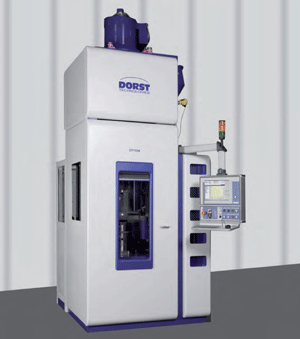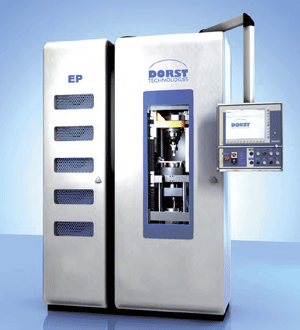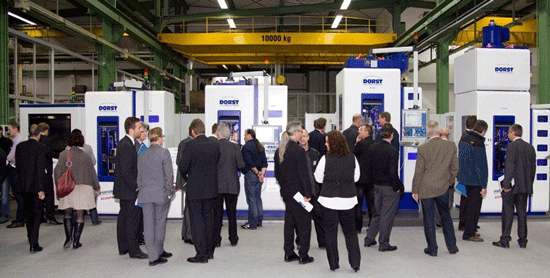Electrical presses offer advanced powder compacting options
Servo-motorised CNC powder presses with closed-loop control systems are the state-of-the-art in powder compaction technology. A sophisticated press can, for example, provide a maximum in full version of eighteen closed-loop controlled systems for powder compaction. These can be six top and six bottom levels each, plus the top punch, the die and the core rod. In addition, the filler movement is closed-loop controlled for optimised powder filling.

Fig.1 The EP-70M to EP-160M electric press series,
developed by Dorst Technologies for the production
of PM structural parts, are electrical driven CNC
controlled multilevel presses with three upper and
lower levels
In the case of the new electrical powder presses developed by Dorst Technologies, which have pressing forces ranging from 150 to 1600 kN and use the die withdrawal process, all movements of the punches, the die and the core rod are driven by their own servo-motors and backlash-free spindle. The company received the EPMA Award of Excellence in Powder Metallurgy in 2010 for its new compacting press concept.
In his presentation Kreuzpaintner stated that the servo motors used on the new presses are of very compact design and do not require any intermediate elements such as transmission or coupling, because they directly drive the screw spindles.
Each drive motor is equipped with its own measuring system; the closed-loop control is carried out individually and directly on the active axis. This is said to eliminate any inaccuracies resulting from indirect measuring. The combined processing of both signals in the Dorst electronic DVS/DCS® control system guarantees optimum positioning and repeated accuracy of the axes resulting in fast and precise compaction.
The use of this new pressing technology also results in significant increases in press speed, and hence productivity, compared to powder presses with hydraulic drives. There is no need for time-consuming adjustments, for example through hydraulic circuits and hydraulic valves. The correction of the position is carried out directly on the axis, leading to time-saving during every cycle.
Since the maximum torque of the electrical motors, and thus the maximum force, are available at any rotational speed and in any position, the movements can be carried out at the highest speed up to the pressing position. Dorst Technologies claims that electrical presses can be accelerated to the stroke rates known from mechanical high-speed powder presses but without some of the restrictions of the mainly flat shaped PM parts that are produced on mechanical presses.

Fig.2 The EP15 to EP-50 series, with a force range
of 150 to 500 kN, are single level electrically
driven powder presses used for smaller PM parts,
hardmetal cutting tools and ceramics
Kreuzpaintner emphasised that, in order to use all the positive characteristics of servo-motors to the full, the electrical presses developed did not integrate the new drive type into an existing press design but that the emphasis was to build a high rigidity press using a new pre-stressed frame with four columns.
This type of frame ensures optimum stiffness and rigidity – two parameters which are of high priority for dimensional accuracy and close tolerances in pressed compacts.
The positioning and repeating accuracy of the press axes in the new presses is said to be ±0,001 mm and, therefore, easily meets today’s requirements for the tolerances of PM compacts. These accuracies are achieved during every stroke by the extremely high consistency of the rotational speed, which is by a factor of 10 higher compared to the conventional powder presses, and by the measuring systems installed directly into each servo-motor.
The 4-column press frame also gives easy access to the tool area from all sides. The frame has been designed for the application of quick-action clamping systems as well as for the installation of die sets. This allows existing tools used in current production to be adapted to the new machines, reported Kreuzpaintner. He also reported that being based on a modular design, the new electric presses can use parts and complete sub-assemblies which have been successfully applied and proven reliable in other types of presses produced by Dorst Technologies for a number of years.
Fig. 3 The entire range of electrical presses at Dorst: EP15 -EP30 – EP50 – EP70M, displayed during the Dorst Technoshow 2011
Less space, less energy and faster production
The compact design of the electrical powder press and its drive motors allows for space-saving installation compared to the conventional powder presses. For example, an electrical press with a maximum pressing force of 500 kN will require only about 70% of the floor space of a comparable mechanical press. Additionally, the operating level of electric presses is sufficiently low not to require a pit.
The high efficiency factor of the servo-motors is also transmitted to the entire machine. The energy required for an electrical powder press with a nominal pressing force of 500 kN is said to amount to an average of approximately 4 kW (operating at a pressing force of approx. 400 kN and 50 strokes/min). Even a mechanical press operating under the same conditions requires approximately 9.5 kW and the energy demand of a hydraulic press is about five times as much.
In terms of productivity, Kreuzpaintner stated that when pressing flat PM parts, the electrical press can be operated at a significantly higher speed at an optimised number of strokes than equivalent high-speed mechanical presses. In addition, the flexibility of electrical presses allows for production optimisation to be carried out as a function of part geometry and powder flow behaviour. This means that pressing of tall PM parts or those with complex geometries can be done at a lower number of strokes and using auxiliary movements of the filler to ensure adequate filling.

Fig. 4 Complex shape, close tolerance PM and ceramic parts compacted on electrical compacting presses made by Dorst Technologies
Side compaction and cross holes open up new PM part designs
To benefit from the high stiffness in the electrical press, a new concept for a side compacting system as well as a cross-hole system has been developed by Dorst Technologies. The side compaction system consists of a special die platen, including filler platen with integrated drive units, designed for the production of pressed parts with undercuts, for example slots on hardmetal cutting tool tips. The system is said to be a cost-effective alternative to metal injection moulding in terms of its shaping capabilities.
Kreuzpaintner also reported on the development of a cross-hole system for the pressing of parts with a hole in the cross direction to the pressing axis. This involves a die platen of special design with two symmetrically arranged spindle drives to move the lateral pins with programmable travel and force.
The pressing of compacts with a cross hole is carried out by two controlled axes with adjustable positive stops. The cross-hole drilling unit consists of a die holder that serves to hold the die and the mechanical/electrical system for the cross-hole drive on the right and on the left. The cross hole drive on the right or on the left serves to drive the electrically operated cross-hole pin. The respective end position on the inner and outer stop is electrically controlled. A coupling element ensures positive connection of the cross-hole pin with the drive. Special pressing and ejection programs are used to ensure production of compacts with a cross hole.
Complete monitoring and programming of the new Dorst Technologies electrical powder presses are carried out by means of the control system DVS/DCS®, which has proven to be successful for many years on hydraulic powder presses. With this control system all hardware-related and software-related possibilities required for the control of the electrically driven powder presses are available. The software tool “Intelligent Program Generator IPG”® is an integral part of the control system. On the basis of some input data on the geometry of the compact to be pressed, the IPG® calculates the complete pressing process and generates an appropriate machine program.
News | Articles | Market reviews | Search directory | Subscribe to e-newsletter






